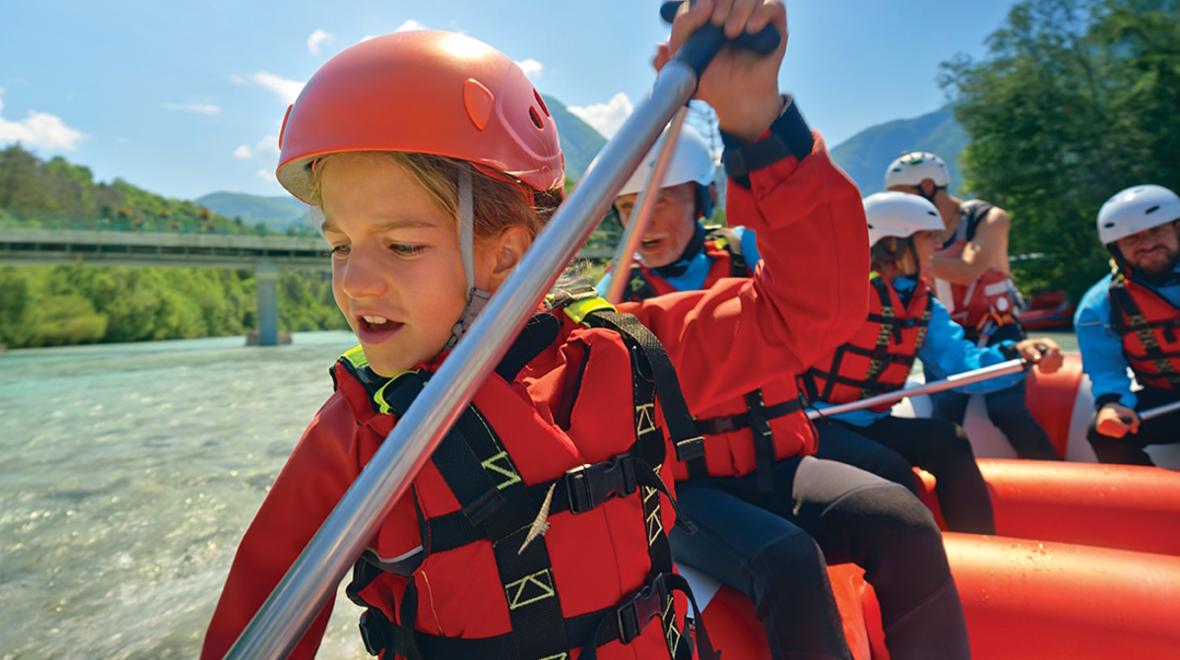
Photo:
Family adventure awaits on a Washington river
Winding through the picturesque landscapes of Washington state, a network of over 70,000 miles of enchanting rivers play a vital role in the region’s ecology, providing habitat for diverse species, cycling nutrients, and maintaining water quality and supply. They also serve as a haven for recreation. Whether you’re seeking your next big catch, thrilling rapids or peaceful stretches for a leisurely float, Washington’s rivers invite families to immerse themselves in the beauty of the Pacific Northwest from a new perspective.
A river fishing guide for Washington families
Washington’s rivers teem with diverse fish, including trout, shad and salmon. With the right guide, young anglers have ample opportunity to reel in their first catch from many of the rivers around the state, year around.
River fishing can be highly technical; between the gear, the need for a boat (or specific gear) and crowds at peak seasons, working with an experienced outfitter is the way to go. Several outfitters around the state offer fishing experiences for families. Participants learn how to safely navigate river waters via wading, casting or trolling (pulling bait on a line behind the boat, not to be confused with trawling, when a net is pulled) while having a grand adventure. Here are a few options we explored:
- Bradza’s Fly Fishing offers half- and full-day trips on various Washington rivers; trips start at $450. Owner Jeff is a lifelong fisherman dedicated to providing safe and memorable experiences for families. He will customize a trip to meet the location and the experience your family is seeking. Call (253) 307-3210 to plan your adventure.
- Washington Fishing Guide Services. Scotty and Karen Crawford offer tailored family trips on the Columbia River (summer months) starting at $600 or at family rates on a case-by-case basis. Call (360) 820-0400 to customize your trip.
- Blue Heron Guide Service, operating out of Forks, offers half-day trips geared toward families with kids ages 5–14, starting at $450. Trips run June–August.

Before you go ...
Families should familiarize themselves with the specific fishing regulations for the area and species being fished, and adhere to those regulations to ensure responsible and sustainable fishing practices. Here are a few things to know:
- Anglers younger than 14 can fish without a license; anyone 15 or older who plans to cast a line must hold a fishing license, easily purchased online, by calling 360-902-2464, or by visiting a license dealer.
- If you are fishing for salmon, steelhead, sturgeon, halibut or Puget Sound Dungeness crab, all fishers must maintain a catch record card. This card helps the state estimate the recreational catching of specific species. At the end of the season, you mail in your card, even if you catch zero fish.
Don’t miss Washington’s Free Fishing Weekend June 8–9, 2024. The event isn’t specific to any particular river; local organizations around the state host events with fish-centric fun for the whole family. For more tips on how to get started fishing with kids, as well as scoping out some great lake spots, checkout this fishing with kids guide.
Washington white water rafting basics
White water rafting offers an exhilarating adventure for the whole family. Rivers are classified based on the difficulty of their rapids, typically ranging from class I (easy) to class VI (extremely difficult and dangerous). For beginners and families with younger children, seek out class I and II rapids, which tend to have small waves and few obstacles. Class III rapids feature moderate waves, irregular currents and occasional obstacles, which require some paddling skills and teamwork to navigate safely. These rapids can be an option for older kids and those looking for a bit more adventure, while still being manageable for beginners. Outfitters that take guests on rivers with class IV+ rapids typically require prior rafting experience and/or only permit guests who are 18 and older.
Where to find rapids:
- Skagit River, classes I–III. Only 90 minutes from Seattle, the Skagit River is best from the end of June to Labor Day. Alpine Adventures runs the upper Skagit (classes II–III), and Triad River Tours offers floats on the middle Skagit (classes I–II). Although they don’t have age restrictions, both outfitters require participants to weigh at least 50 pounds.
- Wenatchee River, classes I–III. The Wenatchee is best for rafting May through July (and sometimes in early August), with the most intense rapids earlier in the year. The river’s water level drops as the summer progresses, offering calmer floats. River Recreation (accepting ages 5 and older) and Osprey Rafting (accepting ages 4 and older weighing at least 40 pounds) are great options for your littlest rafters. Blue Sky Outfitters will take anyone age 8 or older on Wenatchee’s class III rapids earlier in the season.
- Methow River, classes II–IV. For the biggest thrills, raft the Methow May through July. For calmer floats, you can take family-friendly trips with Alpine Adventures (ages 8 and older) and Methow Rafting (ages 6 and older) in August, when water levels drop.
- Skykomish River, classes I–IV+. The Skykomish is known for its heart-pumping rapids, but Alpine Adventures offers float trips for families with kids as young as 3 years old in May and June. Outdoor Adventure Center allows kids ages 6 and older.
- Hoh River, class II. From March through September, Hoh River Rafters takes rafters as young as 5 years old.
- Tieton River, class IIIs. The Tieton is a great choice for your older thrill seekers. River Recreation (ages 10 and older) and Osprey Rafting (ages 12 and older) run this river in September.
Prices to raft these rivers start at about $70 per person for a half-day adventure (3–4 hours). Outfitters typically provide rafts, paddles, personal flotation devices (PFDs) and a qualified guide. Outfitters have different age and weight minimums, so always check before booking.
How and where to go river tubing in Washington
Grab an inner tube (purchased for as little as $15), two cars and your PFD, and you are ready to enjoy a leisurely float down one of Washington’s rivers. River tubing is suitable for anyone who can swim, and there are numerous places to float within easy driving distance from Seattle.

You’ll need two cars to do a float on your own: one to park at the take-out point, and one to get you to the start of your trip with your gear. Outfitters like Fall City Floating (Snoqualmie River, Fall City) and Leavenworth Outdoor Center (Wenatchee River, Leavenworth) offer rentals and shuttle services.
Here is a list of rivers to explore with your inflatable:

Tips to make it extra fun:
- Bring an extra inner tube for a cooler
- Use a Frisbee as a paddle
- Stop at all the swimming holes for a dip
Stay safe
As with all outdoor recreation, safety should always be a top priority to ensure an enjoyable experience for everyone involved. Here are some key safety considerations, no matter how you enjoy the water:
- Wear personal flotation devices (PFDs). All participants should wear properly fitting PFDs at all times while on the water.
- Choose a reputable outfitter. Select licensed and experienced outfitters that follow safety protocols and employ trained guides.
- Know your limits. Choose a trip suitable for the experience level and age of participants. Always check age and weight limits.
- Check local weather and water conditions. Water is unpredictable. Always check weather forecasts and river conditions before embarking on your trip. Even if you aren’t using their services, local outfitters will have up-to-date safety information.
- Dress appropriately. Wear non-cotton clothing, layers if needed, and water shoes — no flip-flops!
- Stay hydrated and protected. Bring plenty of water, sunscreen, sunglasses and head coverings to stay hydrated and protected from the sun.
- Be prepared for emergencies. Be familiar with basic river safety techniques, such as how to swim in moving water and what to do in case of a capsize.
- Pack it in, pack it out. Be responsible for your belongings and keep our rivers and the animals that call them home free of litter and pollution.
By adhering to these safety considerations, families can enjoy adventures on the water in Washington while minimizing risks and ensuring a memorable and safe experience for all.
More outdoor adventures |











